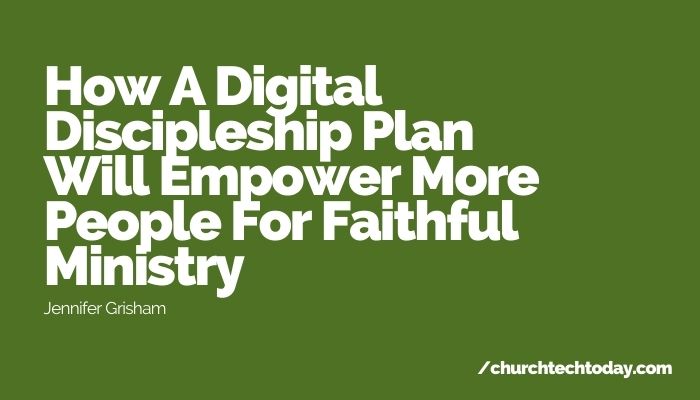To encourage people of all ages and stages to grow in their relationship with Jesus, your church needs to develop a strong digital discipleship plan.
One thing to consider as you strategize is the age and stage of the people in your church. Turns out I'm a geriatric millennial. It’s the first time I’ve ever been called geriatric, though I’ve long deserved it. (Premature grey is only the beginning for me!)
Digital Practice Statistics
A popular article came out recently that defined geriatric millennials as older millennials (born between 1980–1985) who bridge the analog/digital divide. We’re comfortable with phone calls so we communicate well with Gen X and Boomers who remember phone books and want to talk to a real person. And we know how to communicate with younger millennials and Gen Z, who take their questions to Google and never ever want you to leave a voicemail.
With such great disparities in how people of different ages prefer to communicate, how can you care for these people when you have some of everyone in your church?
It all starts with what they have in common.
According to Pew Research:
- 97% of Americans own a phone
- 85% own a smartphone
Backlinko reports:
- 3.9 billion people worldwide use social media
- 58% of people worldwide are active on social media
- 82% of people in North America are active on social
So where can you find everyone? On their phones! (Or tablets or computers.)
Why You Need A Digital Discipleship Plan
Maybe you’re thinking, “Sure, but the online world isn’t real life.” And that’s true—partially. More and more of our lives are impacted by what we do online, from online banking and GPS to email and social media. Churches that skip out on using digital tools for discipleship will miss opportunities to serve God’s people.
Churches that skip out on using digital tools for discipleship will miss opportunities to serve God’s people. Today, the online world IS real life. Click To TweetBe sure to also check out: 3 Ways Your Church Can Live Stream To Improve Discipleship
Having a digital discipleship plan gives pastors and church leaders another way to teach their congregations that all of life is discipleship, from their waking and sleeping to their work, the way they spend their time, and the people they know. You can keep track of people better and help them find a home at your church, and you can empower more people for ministry. Digital discipleship is part of an integrated, holistic method to help people grow in their relationship with Jesus.
Below, I'll share the digital discipleship tools that fit each of the six stages of church investment.
Valuable Digital Discipleship Tools For All 6 Stages Of Church Investment

Stage 1: Discover
This is where people find out about your church for the very first time. It’s also where you get your first opportunity to meet people in your community and welcome them with the love of Christ.
However, you still have people at stage 0: they have no idea your church exists. So getting them into stage 1 requires asking (and answering) two questions:
- How can people find your church? (Take into account both digital and physical means, like your church’s Facebook account and street sign.)
- How will you collect people’s info and follow up with them?
A person in stage 1 hasn’t attended a weekend service, but they may be interested. Making a positive first impression is a good way to prepare someone to move into the second stage.
What about Stage 0 of digital discipleship? To start the process, people must be able to locate your church, physically and digitally. Regularly check the findability of your church. Click To TweetGoal for Stage 1
Move people from strangers to known.
Digital Discipleship Tools
Church website, social media, live streaming, and community outreach.
Make your ChMS work for you: 5 Ways To Use Your Church Management System For Retention
Stage 2: Attend
In this stage, people will make the step (or perhaps the leap!) of visiting during your church’s weekly gathering. Visiting a new church can be a scary thing, particularly for unchurched or dechurched folks in your community.
Online tools can make this stage just a bit easier for your guests. Start by putting yourself in a church visitor’s shoes. What are they afraid of? What questions do they have that they may not feel comfortable asking? Go out of your way to make those answers easy to find, and be available if someone wants to call or email with other questions.
Goal for Stage 2
Encourage people to attend for the first time.
Digital Discipleship Tools
Digital discipleship in the Attend phase of church involvement includes publishing clear pages on your church website covering what to expect on Sunday and kids’ classes, contact form on your website, digital connection cards, and automated emails welcoming guests.
Stage 3: Connect
People will stay in the Attend phase for a little while—after all, it takes more than a minute to get acclimated to a new church, new people, and new ways of doing ministry.
But in this stage, people begin to feel a sense of ownership. They’ll go from talking about the church they’re visiting to calling it “my church,” and they’ll start taking steps to get involved beyond Sunday morning (or whenever your church meets).
You shouldn’t rush people into this stage—I’ve heard a pastor say it’s like asking someone to marry you on the first date. But you can make it easier for someone to jump in when they’re ready. A couple of simple ways to do it:
- Make people feel like they’re wanted: give them a thank-you gift and try to introduce them to people who live nearby or share something in common (interests, job, etc.).
- Have clear, simple next steps you can invite them to: join a small group, support a cause or missions opportunity, or attend membership (or 101-style) class.
Goal for Stage 3
Move people from attending to belonging.
Digital Discipleship Tools
To disciple digitally during this transitional stage, introduce them to the online church community, church events calendar and registration, online giving, and people database navigable by interests and geography.
Stage 4: Serve
When people feel like they belong somewhere, they want to invest their time, talent, and treasure into it. In churches, this looks like serving and giving more regularly, but people don’t want to check off the “yes, I served this week” box—they want to make your church’s mission a reality.
I know what you’re thinking: “But we need kids’ ministry volunteers! And people to take out the trash! And someone to cover a shift at the food bank!” I get it, but hear me out—when you make it clear how every minute, every task, and every dollar supports the mission, people will be more eager to jump in with both feet.
Goal for Stage 4
Enlist people to start serving.
Digital Discipleship Tools
Include people in your church's mission during the Serve stage of your digital discipleship plan. Here's how: use direct messaging or online meetings with church staff and volunteers. Utilize digital platforms for volunteer management, online group messaging, online giving, and your people database navigable by spiritual gifts and skills.
Trying to inspire church attendees to serve and give more regularly? Cast a clear vision and inspire people to make the church's mission a reality! When people feel a sense of belonging, they want to invest. Click To TweetStage 5: Grow
As people enter the Grow phase, your job changes slightly—instead of trying to pull people into this phase, you start trying to push them into the next one.
So, what do people need to grow? In general, people need material geared toward their preferred learning style (auditory, visual, kinesthetic), and they need experience, repetition, safety, and play.
And when people are growing in their faith, they need all those things PLUS the Bible, resources to help them find biblical answers to questions, and a community where everything comes together. In this stage of digital discipleship, personal responsibility and empowerment are key.
Goal for Stage 5
Empower people to grow and become self-feeders.
Digital Discipleship Tools
Use and recommend your favorite Bible app, Bible videos and books, online small group, and Bible reading plans.
More helpful ministry tools: 6 Top Scheduling Software Tools and Apps to Solve Planning Confusion
Stage 6: Share
No one ever graduates from the Grow stage, but as people keep going deeper in their relationship with God, they naturally begin to share their faith with people around them. For some, it could look like evangelism, outreach, or inviting people to church. For others, it could be leading small groups or joining church staff.
Regardless of how people share, you can prepare and equip them to move to the next step with a thoughtful digital discipleship plan.
Goal for Stage 6
Prepare people to share their faith wherever they go.
Digital Discipleship Tools
Equip followers in this stage with video evangelism and theology training, online groups for leaders and trainees, and social media involvement.
Bringing it all together
There’s a ton more I could say about each stage, but perhaps the best way to close this article is to remind you of two things:
First, some of the ideas above span digital and in-person means, and that’s because we live in both of those worlds. We do a lot online and a lot in person.
Second, you have to find a digital discipleship strategy that works for your church. Every church and community is different, and that’s a good thing! Above all else, remember that God has placed you in a specific context, and your job is to adapt your ministry methods to fit your people.
A Free Guide To Help You Sustain A Digital Discipleship Plan
You can learn more about how to build a healthy, sustainable digital discipleship system in this free guide from Faithlife. It has a lot of practical ideas you can put to work both short-term and long-term so you can minister more effectively in your community.
And if you’re not sure how you could really pull off a digital discipleship plan like this, I want to encourage you to look at Faithlife Equip. It’s the first-ever integrated ministry platform—an all-in-one church software that has things like church management, online giving, websites, events, and lots of biblical content like books and videos. Faithlife’s integrated ministry platform has what you need for your weekly services, but instead of needing a handful of logins, it’s all in one connected platform that’s built to work like a church does. Learn more about Faithlife Equip.




